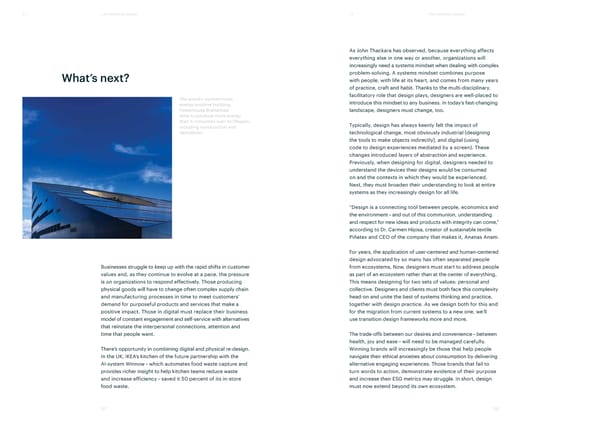T7 Life-centered design T7 Life-centered design As John Thackara has observed, because everything affects everything else in one way or another, organizations will increasingly need a systems mindset when dealing with complex What’s next? problem-solving. A systems mindset combines purpose with people, with life at its heart, and comes from many years of practice, craft and habit. Thanks to the multi-disciplinary, The world’s northernmost facilitatory role that design plays, designers are well-placed to energy-positive building, introduce this mindset to any business. In today’s fast-changing Powerhouse Brattørkaia landscape, designers must change, too. aims to produce more energy than it consumes over its lifespan, Typically, design has always keenly felt the impact of including construction and demolition. technological change, most obviously industrial (designing the tools to make objects indirectly), and digital (using code to design experiences mediated by a screen). These changes introduced layers of abstraction and experience. Previously, when designing for digital, designers needed to understand the devices their designs would be consumed on and the contexts in which they would be experienced. Next, they must broaden their understanding to look at entire systems as they increasingly design for all life. “Design is a connecting tool between people, economics and the environment – and out of this communion, understanding and respect for new ideas and products with integrity can come,” according to Dr. Carmen Hijosa, creator of sustainable textile Piñatex and CEO of the company that makes it, Ananas Anam. For years, the application of user-centered and human-centered design advocated by so many has often separated people Businesses struggle to keep up with the rapid shifts in customer from ecosystems. Now, designers must start to address people values and, as they continue to evolve at a pace, the pressure as part of an ecosystem rather than at the center of everything. is on organizations to respond effectively. Those producing This means designing for two sets of values: personal and physical goods will have to change often complex supply chain collective. Designers and clients must both face this complexity and manufacturing processes in time to meet customers’ head-on and unite the best of systems thinking and practice, demand for purposeful products and services that make a together with design practice. As we design both for this and positive impact. Those in digital must replace their business for the migration from current systems to a new one, we’ll model of constant engagement and self-service with alternatives use transition design frameworks more and more. that reinstate the interpersonal connections, attention and time that people want. The trade-offs between our desires and convenience – between health, joy and ease – will need to be managed carefully. There’s opportunity in combining digital and physical re-design. Winning brands will increasingly be those that help people In the UK, IKEA’s kitchen of the future partnership with the navigate their ethical anxieties about consumption by delivering AI-system Winnow – which automates food waste capture and alternative engaging experiences. Those brands that fail to provides richer insight to help kitchen teams reduce waste turn words to action, demonstrate evidence of their purpose and increase efficiency – saved it 50 percent of its in-store and increase their ESG metrics may struggle. In short, design food waste. must now extend beyond its own ecosystem. 97 98
 xReport Page 55 Page 57
xReport Page 55 Page 57